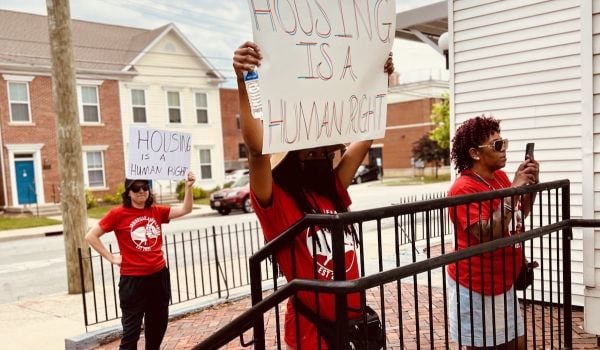This November, Colorado residents will vote on a far-reaching ballot initiative that would set aside 0.1% of the state’s income taxes - estimated to be $290 million in 2023 and beyond - for affordable housing. Proposition 123 would provide grants and low-interest loans for affordable housing and give down payment assistance for first-time homeowners.
The proposition is meant to address affordability as well as housing supply; funds would only go to localities that commit to increasing their affordable housing stock by 3% each year and which fast-track their housing approvals.
As a whole, Prop. 123 could prove to be a necessary and robust response to the state’s housing crisis. But the proposition’s most groundbreaking aspect may be a new model for funding affordable housing that prioritizes tenants.
Prop. 123 sets aside between $69.6 million to $121.8 million a year for a “tenant equity vehicle” would redirect the value of state-funded affordable housing back to tenants, much in the same way homeowners can access the equity in their homes. According to the provision, the state would invest in new low and middle-income housing units, then provide “renters living in these units for at least a year with a share of the money made on the development.” The money can “be used for the renters’ future purchase of a home,” although the language does not bar other uses of the funds.
The provision is risky; it requires individual developers to opt-in, relying on low-interest loans as incentives, and the minute details of how the provision would function would only be hammered out if the proposition passes. But if done right, advocates believe the tenant equity model could tip the economic scales toward renters, who often lack the capital to leave tenancy and become homeowners and who are trapped in extractive relationships with their landlords.
“You have a significant number of renters who are willing to be homeowners or wanting to build wealth, and this is the best way to do that if they’re already paying for the cost of delivering returns for investors,” says Santhosh Ramdoss, the chief investment officer at Gary Community Ventures, one of the proposition’s main financial backers and one of the organizations developing its tenant equity model.
Typically, affordable housing is financed through a combination of grants, federal Low Income Housing Tax Credits (LIHTC) and loans from private banks and financial institutions. LIHTC requires developers to set aside a certain percentage of units as affordable. Private lenders, however, are hesitant to provide funding for buildings where the rent is too low because it’s considered riskier. This has led to a dynamic where many affordable housing developers push to produce only as many affordable units as they need to qualify for LIHTC, often falling short of what the most low-income residents need to remain in their neighborhoods.
Prop. 123 would offer a public alternative to private lenders. The state’s housing agency, acting as a lender, would offer lower interest rates to developers than they would find on the private market and then pass a portion of profits from the building back to renters. While the language in the law does not explicitly state that Colorado Housing and Finance Authority (CHFA) would act as the lender, Ramdoss believes this would be the appropriate agency.
“Our hope is that when those returns come back, the state decides to not use that money to improve its own balance sheet, but put it back into renter wealth,” he says. Because the program still needs to be defined, it’s not clear yet if the money would come from the interest payments on loans, on payouts if the building is sold, a refinancing structure or all three. But the idea is that the building’s value would be passed along to tenants rather than just owners or financiers.
“As your property appreciates in value, some of that gets conveyed over to your tenants, almost as if they were partial owners,” Ramdoss says. “It’s something you don’t really see outside of co-ops or actual homeownership.”
The blueprint for how tenants access these funds also has to be worked out, but some ideas being examined are a fund for down payments on homes or an individual trust account for each tenant that can be accessed without restriction.
“It’s just kind of a radical departure from how real estate and power between landlords and tenants versus homeowners works in this country,” says Jonathan Cappelli, executive director of Neighborhood Development Collaborative, one of the main supporters of the Yes on Prop. 123 campaign. “This ability to actually build equity when you’re not a homeowner is a game changer for the people that we work with,” he says, referring to low-income renters.
The success of the tenant equity provision could depend on how many developers want to access the state’s low-interest loans. Because they can be combined with LIHTC and other forms of financing and would offer more generous interest rates than can be found on the private market, Ramdoss and other advocates are betting that many people will.
“Affordable housing developers are struggling to access capital,” Ramdoss says. The idea would be to bring developers to the table based on their finances.
“One of the core ideas that we’ve designed around is the fact that developers aren’t really coming to participate in terms of the tenant equity vehicle,” he says. “Developers are coming for capital that is affordable and appropriate for their needs.”
While there aren’t any large-scale examples of tenant equity beyond co-ops, where tenants are partial owners in their buildings, the nonprofit Enterprise recently announced a Renter Wealth Creation Fund that would offer renters cashback for on-time payments as well as a share of the property’s appreciation. That fund would pay renters who have lived in their property for at least four years and only when the building is sold or refinanced.
Cappelli believes developers who want to be competitive when applying for LIHTC, which prioritizes projects with deeper affordability, could rely on low-interest funds from the tenant equity vehicle to keep rents low.
“If you’re working on the lower end of the income spectrum… you’re even more incentivized to have really low interest rates,” he says.
Prop. 123 faces a number of risks if it passes. Because localities must opt in, there is a chance that many jurisdictions will refuse the funding to avoid the sped-up timeline for approving housing and the 3% increase to affordable housing stock. According to the Common Sense Institute, a fiscal think tank, the state could end up loosening its program requirements to get more jurisdictions to opt-in, leading to a patchwork of different regulations.
There are also risks associated with the tenant equity vehicle - developers might not apply for funding, and as with any building, projects could lose money if the building depreciates in value or tenants can’t afford rent. (As a possible solution, Ramdoss suggests spreading risk across the program’s entire portfolio so that equity is based on the value generated by all the participating buildings.)
Ultimately advocates believe it is worth the risk to find ways to even the economic playing field between homeowners and renters, especially lower-income renters locked out of the housing market.
“It will require communities to make changes to how they’ve typically approved or treated affordable housing developments, but in ways that’s going to benefit everyone,” Cappelli says. He says the alternative is that lower-income renters continue to be locked out of homeownership.
“This has to work,” he says. “Otherwise we reconcile ourselves to a pretty stark, class-based homeownership access structure for our state.”
This article is part of Backyard, a newsletter exploring scalable solutions to make housing fairer, more affordable and more environmentally sustainable. Subscribe to our weekly Backyard newsletter.

Roshan Abraham is Next City's housing correspondent and a former Equitable Cities fellow. He is based in Queens. Follow him on Twitter at @roshantone.


















